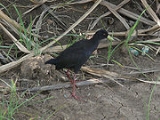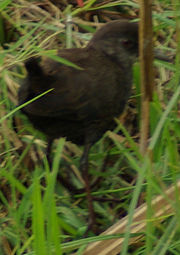
Black Crake
Encyclopedia
The Black Crake, Amaurornis flavirostra, is a waterbird in the rail and crake family Rallidae
. It breeds in most of sub-Saharan
Africa
except in very arid areas. It undertakes some seasonal movements
in those parts of its range which are subject to drought. No subspecies have been described.
The sexes are similar, but the male is slightly larger. Most males, but only 10% of females, have a hooked upper mandible. The immature bird has brown upperparts and a dark grey head and underparts. Its bill is greenish yellow, and its feet and legs are dull red. The downy chicks are black, as with all rails.
The main call of the Black Crake is a duet, starting with a throaty chattering krrrok-kraaaa. The response is a dove-like
cooing coo-crr-COO.
es of all types, as long as there is some vegetation to provide cover. Many rails are very secretive, but the Black Crake is often seen out in the open. It has benefited from human activity in the form of deforestation, and is rarely hunted because of its unpalatable flesh.
 The Black Crake is extremely aggressive when breeding and will attack birds of many species, but especially other rails. It will attack and kill rails of species as large as itself.
The Black Crake is extremely aggressive when breeding and will attack birds of many species, but especially other rails. It will attack and kill rails of species as large as itself.
The nest is a deep neat bowl made from wetland plants and built by both sexes in marsh vegetation or on the ground in a dry location. The nest is also sometimes constructed up to 3 m high in a bush.
The two to six, usually three, eggs are cream or white, and spotted with brown or chestnut. Both parents, sometimes assisted by the young from previous broods, incubate for 13–19 days to hatching. The precocial
chicks leave the nest in 1–3 days, but are fed by parents and helpers for several weeks. They can fly by 5–6 weeks, and are independent at 6–12 weeks.
s, small fish
, frog
s and seed
s. It will take the eggs of birds and scavenge on carcasses. It will forage on the ground or climb reeds to find prey including flying insect
s.
This species will perch on hippopotamus
es and warthog
s and remove parasites.
Rallidae
The rails, or Rallidae, are a large cosmopolitan family of small to medium-sized birds. The family exhibits considerable diversity and the family also includes the crakes, coots, and gallinules...
. It breeds in most of sub-Saharan
Sahara
The Sahara is the world's second largest desert, after Antarctica. At over , it covers most of Northern Africa, making it almost as large as Europe or the United States. The Sahara stretches from the Red Sea, including parts of the Mediterranean coasts, to the outskirts of the Atlantic Ocean...
Africa
Africa
Africa is the world's second largest and second most populous continent, after Asia. At about 30.2 million km² including adjacent islands, it covers 6% of the Earth's total surface area and 20.4% of the total land area...
except in very arid areas. It undertakes some seasonal movements
Bird migration
Bird migration is the regular seasonal journey undertaken by many species of birds. Bird movements include those made in response to changes in food availability, habitat or weather. Sometimes, journeys are not termed "true migration" because they are irregular or in only one direction...
in those parts of its range which are subject to drought. No subspecies have been described.
Description
The adult Black Crake is 19–23 cm long with a short tail and long toes. As its name implies, the adult has mainly black plumage, with a brown olive tone on the wings and upperparts which is rarely detectable in the field. The eye is red, the bill is yellow (hence the flavirostra of the binomial name), and the legs and feet are red, duller when not breeding.The sexes are similar, but the male is slightly larger. Most males, but only 10% of females, have a hooked upper mandible. The immature bird has brown upperparts and a dark grey head and underparts. Its bill is greenish yellow, and its feet and legs are dull red. The downy chicks are black, as with all rails.
The main call of the Black Crake is a duet, starting with a throaty chattering krrrok-kraaaa. The response is a dove-like
Dove
Pigeons and doves constitute the bird family Columbidae within the order Columbiformes, which include some 300 species of near passerines. In general terms "dove" and "pigeon" are used somewhat interchangeably...
cooing coo-crr-COO.
Habitat and status
The habitat of this common to abundant species is freshwater marshMarsh
In geography, a marsh, or morass, is a type of wetland that is subject to frequent or continuous flood. Typically the water is shallow and features grasses, rushes, reeds, typhas, sedges, other herbaceous plants, and moss....
es of all types, as long as there is some vegetation to provide cover. Many rails are very secretive, but the Black Crake is often seen out in the open. It has benefited from human activity in the form of deforestation, and is rarely hunted because of its unpalatable flesh.
Breeding

The nest is a deep neat bowl made from wetland plants and built by both sexes in marsh vegetation or on the ground in a dry location. The nest is also sometimes constructed up to 3 m high in a bush.
The two to six, usually three, eggs are cream or white, and spotted with brown or chestnut. Both parents, sometimes assisted by the young from previous broods, incubate for 13–19 days to hatching. The precocial
Precocial
In biology, the term precocial refers to species in which the young are relatively mature and mobile from the moment of birth or hatching. The opposite developmental strategy is called "altricial," where the young are born or hatched helpless. Extremely precocial species may be called...
chicks leave the nest in 1–3 days, but are fed by parents and helpers for several weeks. They can fly by 5–6 weeks, and are independent at 6–12 weeks.
Feeding
The Black Crake is diurnal, and this confiding bird will feed close to humans and often in the open. It eats a wide range of invertebrateInvertebrate
An invertebrate is an animal without a backbone. The group includes 97% of all animal species – all animals except those in the chordate subphylum Vertebrata .Invertebrates form a paraphyletic group...
s, small fish
Fish
Fish are a paraphyletic group of organisms that consist of all gill-bearing aquatic vertebrate animals that lack limbs with digits. Included in this definition are the living hagfish, lampreys, and cartilaginous and bony fish, as well as various extinct related groups...
, frog
Frog
Frogs are amphibians in the order Anura , formerly referred to as Salientia . Most frogs are characterized by a short body, webbed digits , protruding eyes and the absence of a tail...
s and seed
Seed
A seed is a small embryonic plant enclosed in a covering called the seed coat, usually with some stored food. It is the product of the ripened ovule of gymnosperm and angiosperm plants which occurs after fertilization and some growth within the mother plant...
s. It will take the eggs of birds and scavenge on carcasses. It will forage on the ground or climb reeds to find prey including flying insect
Insect
Insects are a class of living creatures within the arthropods that have a chitinous exoskeleton, a three-part body , three pairs of jointed legs, compound eyes, and two antennae...
s.
This species will perch on hippopotamus
Hippopotamus
The hippopotamus , or hippo, from the ancient Greek for "river horse" , is a large, mostly herbivorous mammal in sub-Saharan Africa, and one of only two extant species in the family Hippopotamidae After the elephant and rhinoceros, the hippopotamus is the third largest land mammal and the heaviest...
es and warthog
Warthog
The Warthog or Common Warthog is a wild member of the pig family that lives in grassland, savanna, and woodland in Sub-Saharan Africa. In the past it was commonly treated as a subspecies of P...
s and remove parasites.

